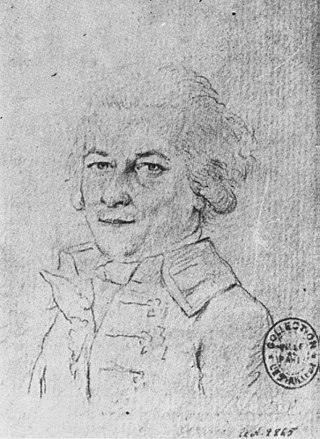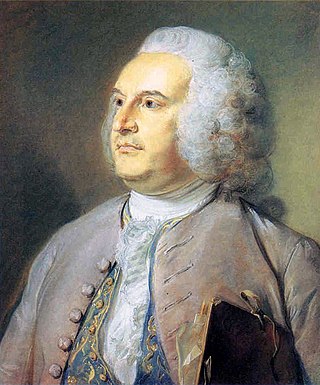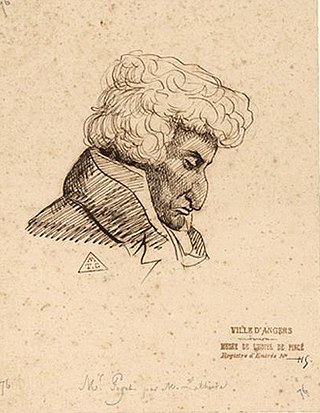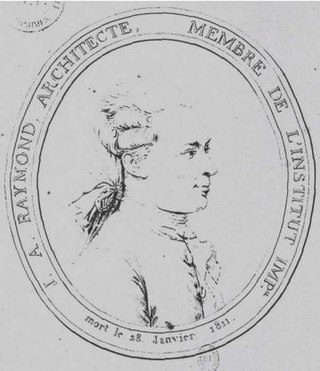Related Research Articles

The Académie royale de peinture et de sculpture was founded in 1648 in Paris, France. It was the premier art institution of France during the latter part of the Ancien Régime until it was abolished in 1793 during the French Revolution. It included most of the important painters and sculptors, maintained almost total control of teaching and exhibitions, and afforded its members preference in royal commissions.

Ange-Jacques Gabriel was the principal architect of King Louis XV of France. His major works included the Place de la Concorde, the École Militaire, and the Petit Trianon and opera theater at the Palace of Versailles. His style was a careful balance between French Baroque architecture and French neoclassicism.

Jacques-François Blondel was an 18th-century French architect and teacher. After running his own highly successful school of architecture for many years, he was appointed Professor of Architecture at the Académie Royale d'Architecture in 1762, and his Cours d'architecture largely superseded a similarly titled book published in 1675 by his famous namesake, François Blondel, who had occupied the same post in the late 17th century.

Pierre Contant d'Ivry, was a French architect and designer working in a chaste and sober Rococo style and in the goût grec phase of early Neoclassicism.

The Académie Royale d'Architecture was a French learned society founded in 1671. It had a leading role in influencing architectural theory and education, not only in France, but throughout Europe and the Americas from the late 17th century to the mid-20th.

Charles de Wailly was a French architect and urbanist, and furniture designer, one of the principals in the Neoclassical revival of the Antique. His major work was the Théâtre de l'Odéon for the Comédie-Française (1779–82). In his designs, de Wailly showed a predilection for the perfect figure, the circle.

Antoine Lepautre or Le Pautre (1621–1679) was a French architect and engraver. Born in Paris, he was the brother of the prolific and inventive designer-engraver Jean Lepautre. Antoine Lepautre has been called "one of the most inventive architects of the early years of Louis XIV's reign". He was a protégé of Cardinal Mazarin, to whom he dedicated his Desseins de plusieurs palais, in which his imagination is given free rein.

Alphonse Hubert François Balat was a Belgian architect.

Jean-Michel Chevotet was a French architect. He and Pierre Contant d'Ivry were among the most eminent Parisian architects of the day and designed in both the restrained French Rococo manner, known as the "Louis XV style" and in the "Goût grec" phase of early Neoclassicism. His grandson was Pierre-Jean-Baptiste Chaussard.

Hendrik Beyaert (Dutch) or Henri Beyaert (French) was a Belgian architect. He is considered one of the most important Belgian architects of the 19th century.

The Royal Academy of Fine Arts of Brussels is an art school in Brussels, Belgium, founded in 1711. Starting from modest beginnings in a single room in Brussels' Town Hall, it has since 1876 been operating from a former convent and orphanage in the Rue du Midi/Zuidstraat, which was converted by the architect Victor Jamaer. The school has played an important role in training leading local artists.

Henri van Dievoet was a Belgian architect.

Gabriel Van Dievoet was a Belgian decorator and Liberty style sgraffitist. He was the brother of the architect Henri Van Dievoet.

Neoclassical architecture appeared in Belgium during the period of Austrian occupation in the mid-18th century and enjoyed considerable longevity in the country, surviving through periods of French and Dutch occupation, and the birth of Independent Belgium, surviving well into the 20th century.
Thomas Gobert was a 17th-century French architect and engineer.
Nicolas Delespine was a French master mason, entrepreneur and architect. He belonged to a dynasty of Parisian master masons.

Jean-François Heurtier was a French architect.

Bernard Poyet was a French architect, best known for his work on the Palais Bourbon in Paris.

Jean-Arnaud Raymond was a French architect in the Palladian style.

The Château Charles was a neoclassical palace in Tervuren, Belgium. It was intended as summer retreat for prince Charles of Lorraine, governor of the Austrian Netherlands. However, it was soon demolished and nothing remains any more.
References
- ↑ (in French)Académie de Bruxelles, deux siècles d'architecture, Bruxelles, Archives d'architecture moderne, 1989, pp. 35, 38, 79 (note 74), 162, 166, 167, 169, 170, 172, 202.
- ↑ (in French) François de Pierpont, « Le château de Duras », in Le Parchemin, September–October 2009, p. 353.
- ↑ (in French) Anne and Paul van Ypersele de Strihou, Laeken, résidence impériale et royale, Bruxelles, 1970, p. 27
- ↑ (in French) Xavier Duquenne, Le parc de Wespelaar, le jardin anglais en Belgique au XVIII siecle, Bruxelles 2001, pp. 43-55.